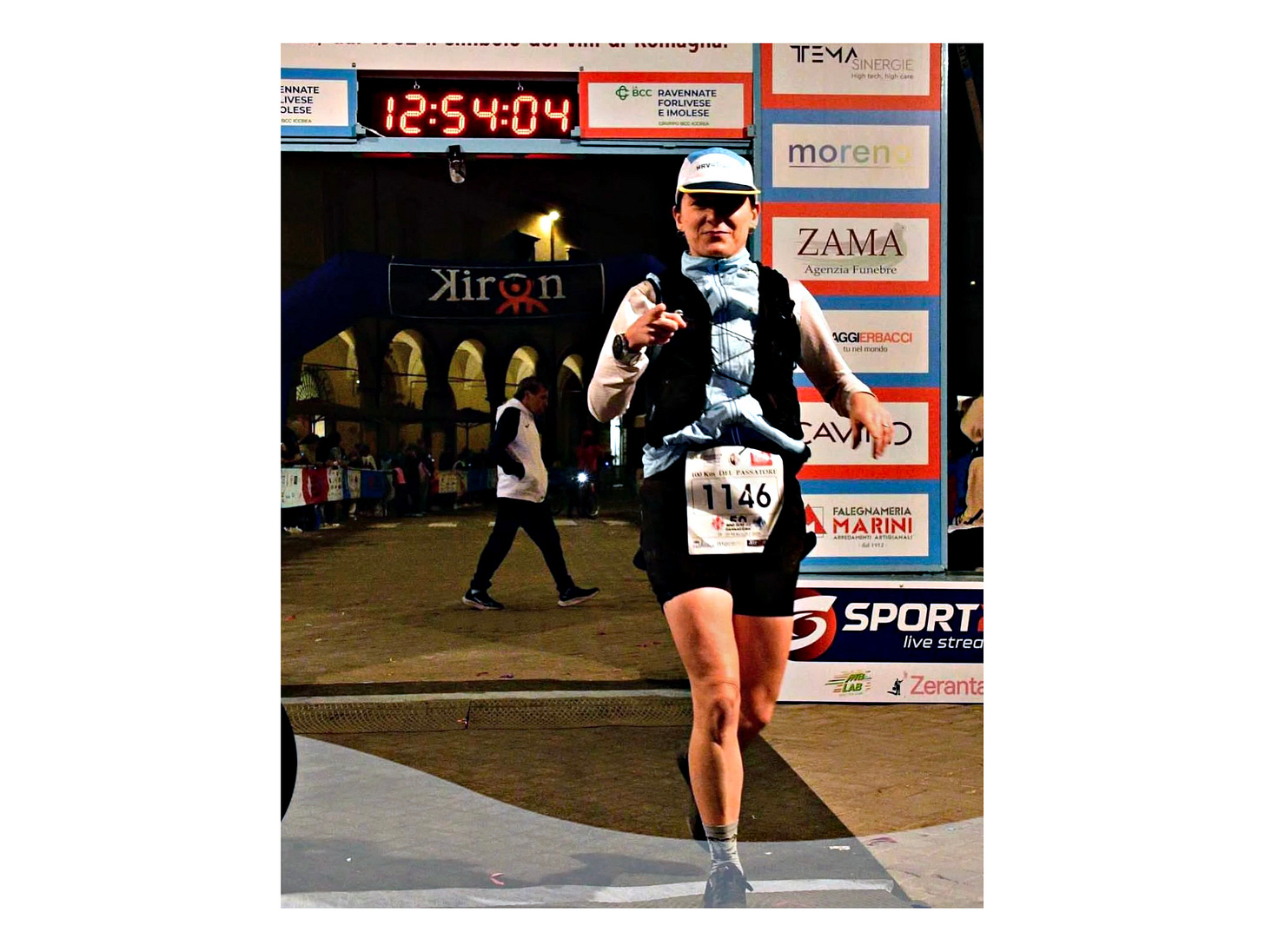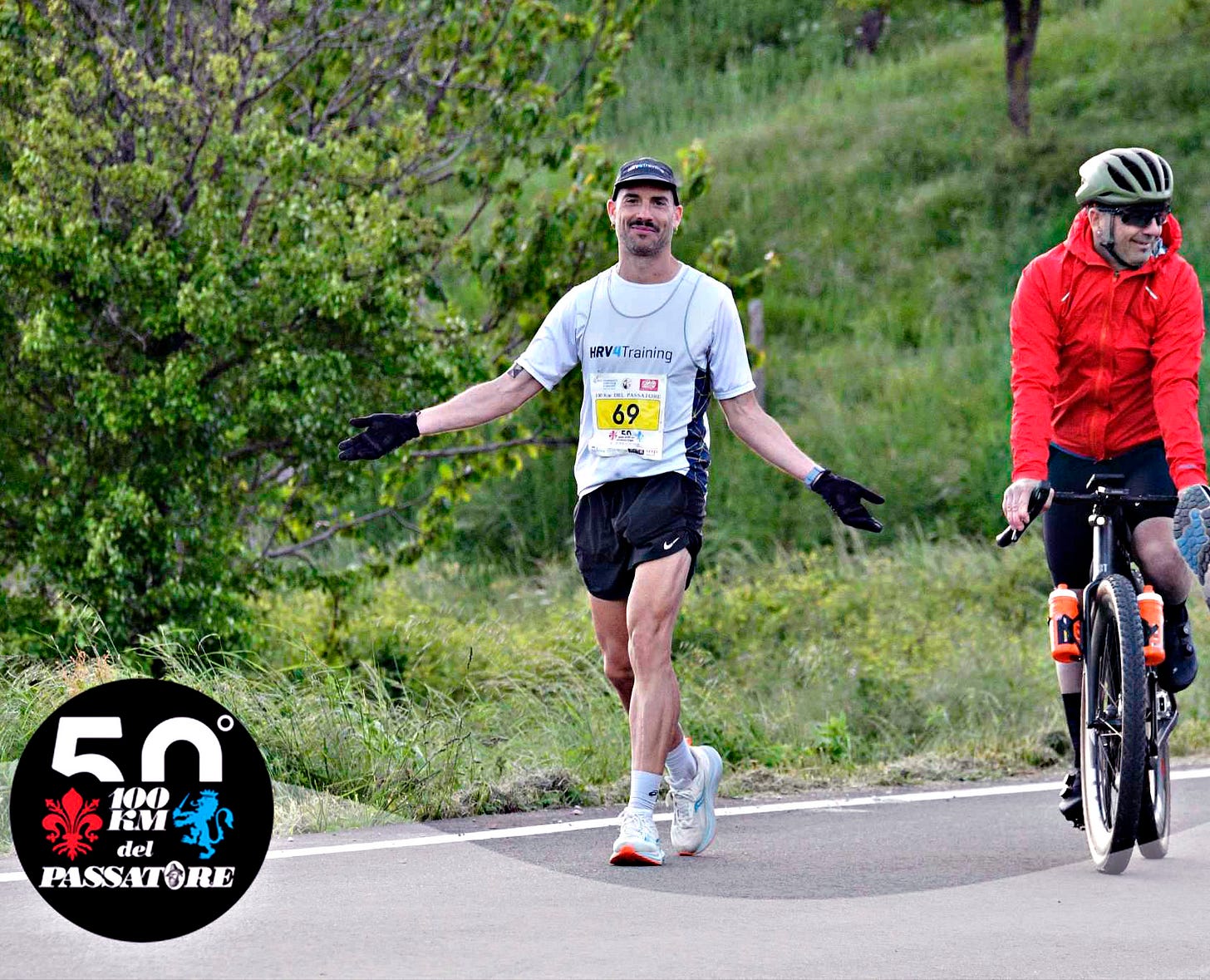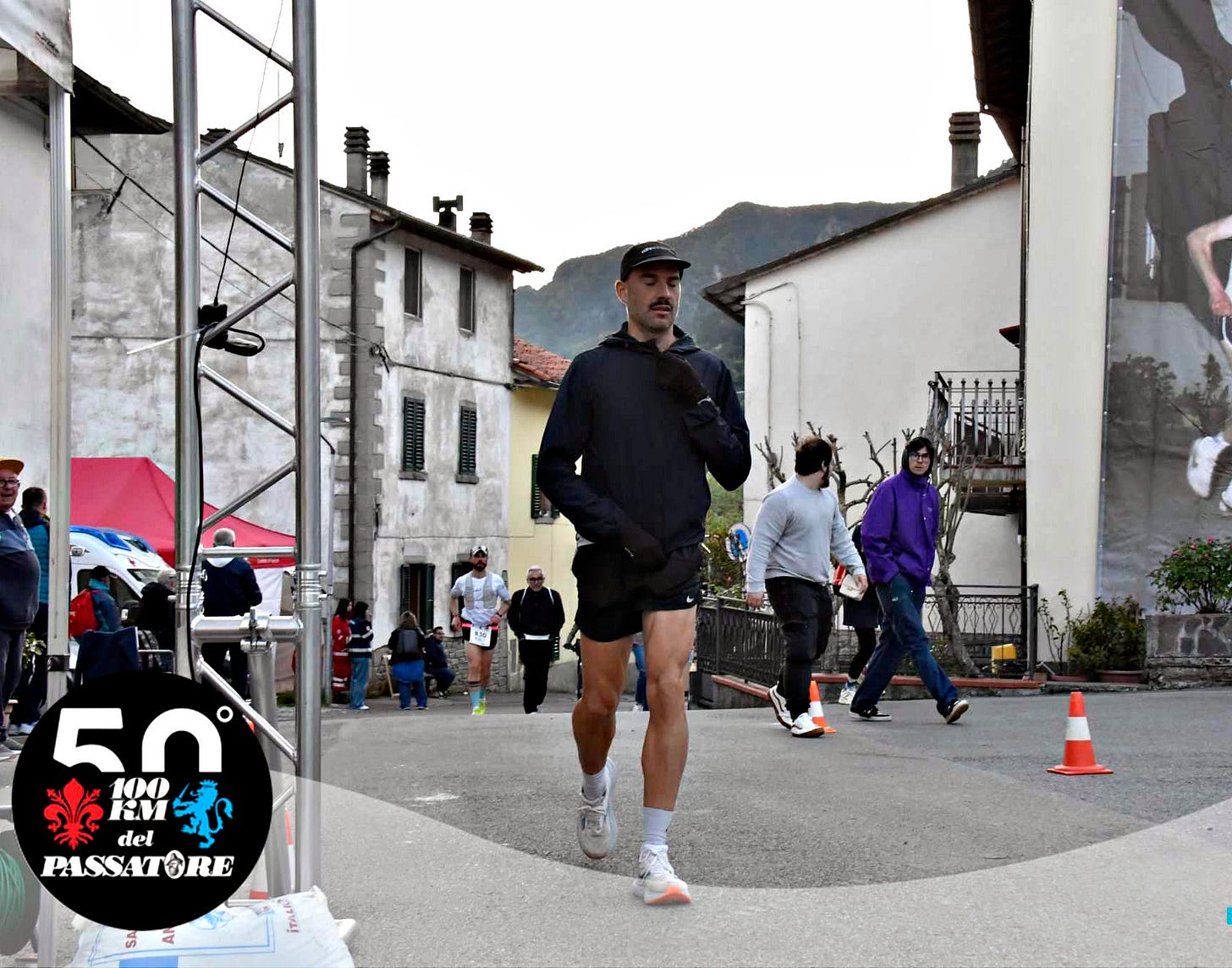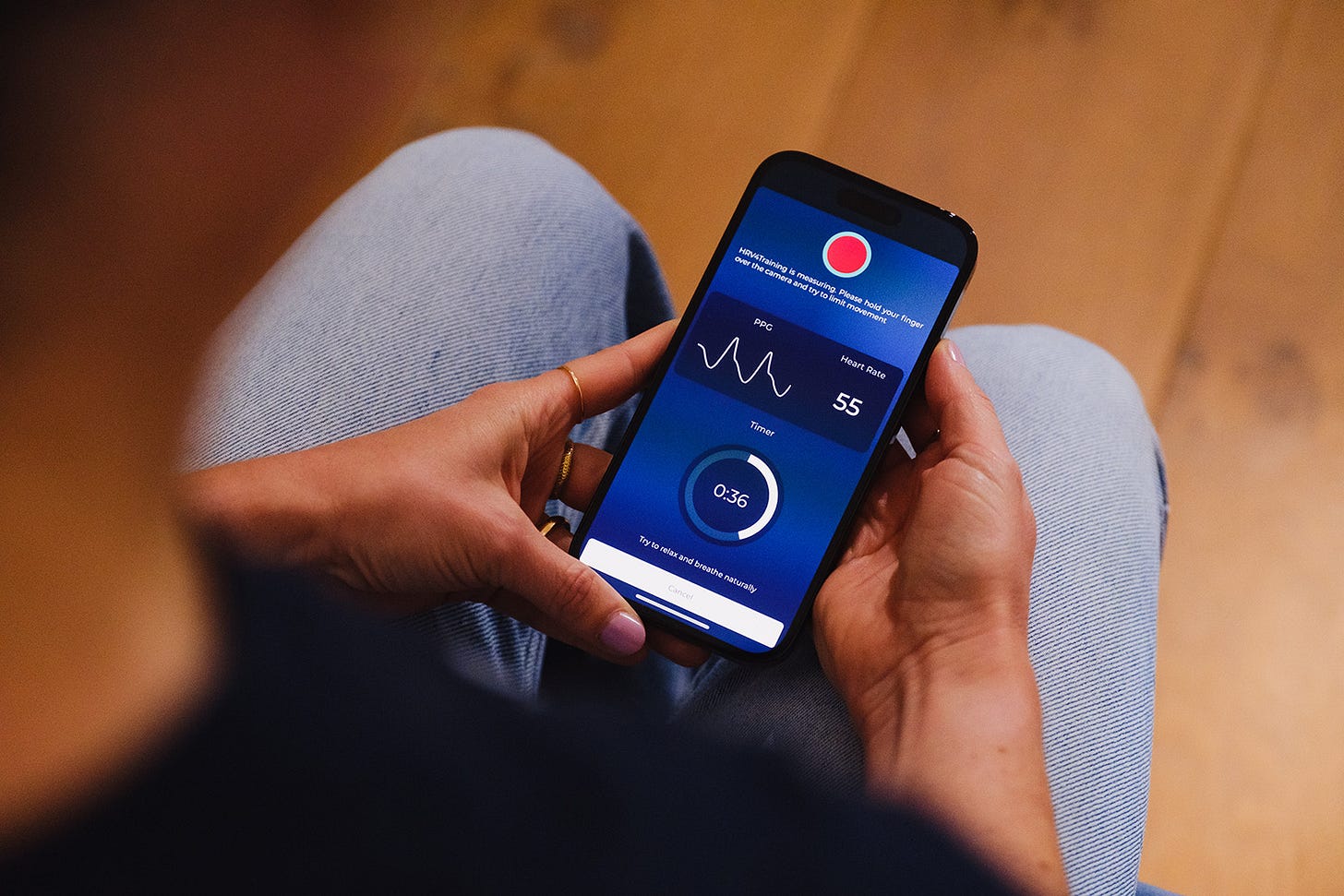If you’ve been here for a while, you know I’m all about the process: training, testing, learning, adapting, and trying to get better at the sport I love. This means sharing the journey when things don’t go well, too. It’s part of the process after all.
This year at Passatore, I had to DNF.
My body hadn’t recovered from the previous 50 km personal best, and I made the call mid-race to stop.
To me, running (and ultrarunning) is not about pushing through at all costs. It’s about getting better so that I can truly enjoy being out there and racing for many hours. This year, it wasn’t possible.
Below are a few thoughts about these past weeks, my training, racing, and learnings. I hope there is something useful for you in there as well.
Race Background and Previous Results
Training for Passatore:
The Big Picture
Specificity: Heat, Hills, and Long Runs
Planned vs Executed
Racing Passatore:
Pacing and Managing Intensity
Nutrition and Hydration
Race Background and Previous Results
The 100 km del Passatore is the oldest road ultramarathon in Italy.
It goes from downtown Florence to Faenza, across the Apennine Mountains and Passo della Colla. For a number of reasons I covered elsewhere, for me, this is THE race, and the only race that truly motivates me to keep pushing my limits and getting really uncomfortable.
I started preparing Passatore for the first time in 2021 and obtained the following results:
2022: DNF
2023: The race was canceled on race week due to the floods in our region. I went to Biel to “use the training” and ran 9h 50’ at Bieler Lauftage for another hilly (albeit easier) 100 km.
2024: Three years since I started training for it, I finally ran Passatore in 9h 25’, closing 67th of 3500 runners.
Training for Passatore
To get better (and race well), we need to understand our limiters. For me, it’s muscular endurance. During a long race, people near me are always breathing harder than me. On the climbs, it’s like they are racing a 5 km. On the downhills, they seem to fly, unconcerned with their quads. If I tried any of that, my legs would last 30 minutes. My cardiorespiratory system is much better than my muscular system, and it’s obvious that I’m at opposite ends of the bell curve for these two aspects. This means that my training and racing strategies need to differ too: I need to be more conservative during the race (when my legs are gone, they are gone, they will be cramping and making it impossible to move - a feeling most runners have never even experienced). In training, I need to spend lots of time on the legs to condition them to be able to handle 100 km of pounding on asphalt, and therefore, I require higher volumes (and more specificity, e.g., hills) than most.
These limiters shape my training, which at this point is rather similar across years, as I have found what works for me in preparation for this event. Below, I cover the high-level periodization that I have used over the past three years.
The Big Picture
At a very high level, my training is structured as follows:
Train for fitness between June and December (i.e., far from the race). The race is in May, hence my Base training starts around June. This typically means marathon training, or using an autumn marathon as an excuse to get as fit as possible. Practically speaking, there will be hard training blocks from mid-summer to early autumn (the usual things, VO2max, Threshold, Tempo), and then I will be racing a marathon somewhere between October and November. During this phase, I do maintain a decent running volume and also long runs and adventures in nature every once in a while, but these are not specific to the 100 km - it’s more for fun than anything else.
Train for specificity between January and May (i.e., before the race). For Passatore, this means hills, race pace, and workouts that tend to be longer (e.g., long hard climbs, tempo/threshold runs). Training in warm weather would be ideal, but it is not practical as the heat gets here only on race week or slightly earlier / later, hence I use passive heat acclimation strategies. Race nutrition is also a big focus of this phase. During this period, I increase volume quite a bit, as being limited from a muscular endurance point of view, it is key that I condition the muscles, more than my cardiorespiratory fitness. More details about specificity, below.
Specificity: Heat, Hills, and Long Runs
Below are a few details on three aspects that are key for Passatore:
Use hills for intensity and specificity. Passatore is 95% hilly and 5% flat. The climbs and descents are really long: we go up 17 km, then down 15 km, then up 16 km, then down 20 km, and then there’s a bit of a slight downhill with some rolling hills. The first two climbs and steep descents mean that you are running quite differently from the way you’d run on the flats, and for hours each time. As such, it is key to train this type of running and become better and more efficient from a neuromuscular point of view. During the last few months of training before the race, I tend to use hills for my hard workouts as well, as a way to limit injury risk and improve efficiency at running uphill.
Use passive heat acclimation to prepare for a hot race (and possibly other gains, e.g., increased hemoglobin mass). I like to keep some of this stimulus also all year round, and possibly get some sort of chronic adaptation / struggle less in warmer weather, which seems to have worked recently.
Keep long runs moderately long, and add intensity (e.g., hard climbs). Limit extremely long runs at race pace to a minimum (e.g., one, many weeks before the race). In particular, I do only one very long run, and I do it early in the season, typically in March, before I get to more specific training, as this is key for me to gain confidence for the distance (given my limiters, there is only one opportunity per year to run this distance, unless I want to stop training, hence it still feels like “it’s too much”). I also use this run to practice fueling and some minor changes I might be doing in terms of clothing or else. This is typically a 70-75km run on a route similar to Passatore (or even on the course). This run is mentally (more than physically) draining, hence I prefer to do it at least 2 months before the race. From that point onwards, I will do long runs that are shorter but provide a greater training stimulus (e.g., 50 km with 10-20km tempo on the climbs, or similar).
Planned vs Executed
What went wrong then?
It was all good until mid-April. I covered my training up to the 50 km di Romagna (April 25th) in detail here, following the principles described above, plus some changes due to periodizing my diet.
As I mentioned at the beginning, I couldn’t bounce back from that race. Initially, I thought I just had really bad DOMS - again, nothing new to me given my limiters - I waited two days and then started training easy, spending time on the legs waiting for soreness to go away. After a while, though, it became clear that I had more serious issues, especially with the adductors, that became painful even outside of training. In the remaining weeks, I lowered volume, went to see a good physio, made some small progress, but I could not turn it around in time for Passatore.

As these issues lasted for quite a while, I think I had accepted sometime during those weeks that it wasn't going to happen this year. I did go into the race hopeful, but when I felt the fatigue and pain already early on, I knew what was coming.
Looking back, I really needed to race the 50 km - for myself - after a long period of underperformance and all the dietary changes, which meant I almost had to start over rebuilding fitness back in January. I am happy I did race, even if it cost me Passatore. I needed “proof” that everything I did to get back into racing and improve worked, as this process opened new possibilities for years to come. I was motivated, eager to race, and I gave all I had at the 50 km, which went beyond my expectations and remains a highlight of this (running) year for me.
I think that back in March and April, I had a few weeks in which I had shifted priorities and "a good race" (either the Lamone marathon - for which I was sick and also had to skip, somewhat contributing to my need to race hard at the following race - or the 50 km di Romagna), was more important than Passatore (sacrilegio).
Next year it will of course be different as now the "need" for running a good 100 km builds up more, given the DNF.
Racing Passatore
Passatore starts at 3 pm in Florence on the last Saturday of May, and as such, it tends to be pretty hot. Add on top of that the climbs (about 33 of the first 48 km are uphill), and managing intensity early on becomes quite essential.
This year, it was unusually windy and not particularly warm, which made for ideal racing conditions (bummer!).
Pacing and Managing Intensity
The goal was a sub-9-hour, and therefore, I was at my limit for the distance (which is the whole point of racing!). Practically speaking, it means that I ran uphill near LT1, so high-end zone 2 in my system, and downhill in lower-end zone 2 (about 10 bpm lower).
I would do this the exact same way as I was careful on the climbs, but still running well, and then I was taking it easy on the downhills, to allow for my heart rate to lower and to limit muscle damage. My pace was very similar to last year’s (exact same splits at Borgo San Lorenzo and Passo della Colla), in which I was running sub-9-hour pace until the last third of the race when I faded a bit.
All good, I think, just not possible to continue while having muscular issues as I did this year.
Nutrition and Hydration
In terms of nutrition, I went to a lower frequency of gel intake given that my needs are much lower than they used to be, now that my metabolic flexibility and fat oxidation have improved (breakdown here).
In particular, I had 1 gel (SIS) every 8 km, and alternated 2 gels and 1 energy bar during the race. I skipped the first gel, so I had the first one at 16 km. After 3-4 hours, I started feeling the usual stomach cramp when having a gel, which lasted about 30 seconds, and then I felt okay. Probably another 2-3 hours, and it would turn into the usual difficulties with nausea.
I hope that this lower frequency of eating helps in getting me to have issues maybe around 80 km instead of 60 km, but I didn’t get that far this time to put to the test my new diet and protocols. On the bright side, despite the relatively low carbohydrate intake, I never felt low energy levels, blood sugar dips, or hunger. I think the intake works well for my current metabolism if I keep up the periodized diet (I had even fewer gels in training before the injury, when running 70km a bit quicker than race pace, see here).
On race day, it was relatively cold (not really at the beginning, but certainly after the first 3 hours), and windy, which made me drink less, and I think it was a mistake. I felt quite thirsty later on, probably because I drank too little for 2-3 hours, due to the cold wind. I was however sweating a lot and losing a lot of sodium, and I should probably try to drink more next time even if I don’t feel like I need it. Something to keep in mind if we ever get another cold or windy Passatore. I also had 1 sodium pill every 16 km. I need to see if this is a good frequency or if I should have one with every gel. My main concern is always “not messing up my stomach” more than anything else.
One of the reasons I decided to show up at the race was to test these protocols, as we don’t get many opportunities to do so, and while I did learn a few things, I wasn’t really out there long enough to clear all doubts.
Wrap up
Racing is always complex; we push ourselves beyond what we do in training, and sometimes it can leave a mark.
For a week or two after the 50 km di Romagna, I thought I was particularly sore, maybe just lots of DOMS, but eventually, it was clear I was actually injured, and while I tried different things (physio, not running, etc.), I could not turn it around in time.
I have no regrets as I changed so many things in the past 6 months, especially with my diet and metabolism, that I wanted really badly to race hard back in April. I hadn’t been as excited to race as I was for the 50 km di Romagna in a very long time. Eventually, it all came together on race day, which, at that time, mattered to me more than Passatore. The changes in metabolism were a new breakthrough that can stay with me for years to come, and were more important than any short-term goal.
Afterwards, it went the way it went. I could never bounce back from that race, and I am sure next year my priorities will be different, and it will be all about Passatore. But for this year, that’s how it went, and I am overall happy with my racing season and with the process.
Despite the DNF, the weekend was incredible; meeting friends, family, racing, Brisighella, then getting on the bike to support Alessandra for the last ~20km of her Passatore. I am extremely grateful for the support and the opportunity to be out there and push my body to its limits once again.
We’re learning, adjusting, and moving forward.
We’re hungry.
The journey to sub-9 hours continues.

How to Show Your Support
No paywalls here. All my content is and will remain free.
As a HRV4Training user, the best way to help is to sign up for HRV4Training Pro.
Thank you for supporting my work.
Endurance Coaching
If you are interested in working with me, please learn more here, and join the waiting list by filling in the athlete intake form, here.
Marco holds a PhD cum laude in applied machine learning, a M.Sc. cum laude in computer science engineering, and a M.Sc. cum laude in human movement sciences and high-performance coaching. He is a certified ultrarunning coach.
Marco has published more than 50 papers and patents at the intersection between physiology, health, technology, and human performance.
He is co-founder of HRV4Training, advisor at Oura, guest lecturer at VU Amsterdam, and editor for IEEE Pervasive Computing Magazine. He loves running.
Social:











Dear Marco,
A short story!
I always regretted not getting to University. When I was approaching retirement I decided to do it. So, aged 67 I applied to study Sport Psychology and I graduated aged 70 with BSc 1st class Honours. As a result I was offered a free place to do an MSc , from which I graduated aged 73.
My point is that sometimes it's not about the race, it's about getting there.
You are already a winner in the eyes of so many of us 'athletes'. Don't compromise your later years by damaging your body now. I have done that and I wish I could undo the damage.
Just remember that more often than not, just getting there is the goal and the reward, for me - the sense of self, is everything I could have wished for.
With respect, I am
Yours sincerely,
Pete
salve ! me again !
Not an unsollicited advice, but I am on the same side of heart > muscles/tendons. I had really bad trails running race where I couyld barely walk downhill (Trail des Templiers 2014 if I recall correctly...)
Today my cardio-respiratory system is not as good but I feel really better in the moutains thanks to strength training. I know you already do some work but for me it was a game changer. I still go backward (french expression) to the gym but it's worth it.
ciao